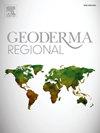Soil carbon benchmarks and cropland management effects: Insights from the Bavarian soil organic matter monitoring
IF 3.1
2区 农林科学
Q2 SOIL SCIENCE
引用次数: 0
Abstract
Soil organic carbon (SOC) is a key property for soil productivity and functionality. According to the Federal Soil Protection Act in Germany, site-specific SOC contents need to be maintained in the course of agricultural land use in order to ensure soil fertility and the performance of soils as a natural resource. In this study, representative SOC benchmarks have been derived for arable mineral soils in Bavaria on the basis of a comprehensive soil organic matter (SOM) monitoring program as reference values for farmers and other stakeholders. Data from 283 representative study sites across Bavaria has been stratified according to the most influential site factors on SOC, particularly clay content and the elevation above sea level as a proxy for climate (temperature and precipitation). Due to an evaluation of the study sites in terms of agricultural management according to the principles of good agricultural practice combined with statistical exclusion of 25 % of extreme SOC contents, the benchmarks presented here can be regarded as representative reference values under specific environmental conditions. However, different management measures within the principles of good agricultural practice also influenced SOC, as organic fertilization and the cultivation of perennial forage crops positively affected SOC contents. In contrast, the cultivation of root crops negatively influenced SOC contents, while the proportion of corn within the crop rotation of up to 50 % did not affect SOC negatively. We further evaluated the suitability of the SOC/clay ratio as alternative SOC and soil structure indicator. However, the SOC/clay ratio seems to be inappropriate due to a high number of degraded sites and a systematic bias towards degradation with high clay contents. The SOC benchmarks presented here provide valuable reference values for farmers policymakers and agricultural stakeholders in optimizing cropland management practices for sustainable soil health and fertility in Bavaria and beyond. However, further research is required regarding the stratification approach and the calculation method for a widespread implementation of SOC benchmarks. Furthermore, the shifting baseline syndrome has to accounted for, so up to date SOC benchmarks remain within a range in which soils are considered healthy and fertile.
土壤碳基准和农田管理效果:来自巴伐利亚土壤有机质监测的见解
土壤有机碳(SOC)是土壤生产力和功能的关键属性。根据德国《联邦土壤保护法》(Federal Soil Protection Act),在农业用地利用过程中,需要保持特定地点的有机碳含量,以确保土壤肥力和土壤作为自然资源的性能。本研究在综合土壤有机质(SOM)监测项目的基础上,对巴伐利亚州可耕矿质土壤进行了具有代表性的有机碳基准分析,为农民和其他利益相关者提供了参考价值。来自巴伐利亚州283个代表性研究地点的数据根据对土壤有机碳影响最大的地点因素进行了分层,特别是粘土含量和海拔高度作为气候(温度和降水)的代表。根据良好农业规范原则对研究点进行了农业管理评价,并统计排除了25%的极端有机碳含量,本文提出的基准可以作为特定环境条件下具有代表性的参考值。然而,在良好农业规范的原则下,不同的管理措施对土壤有机碳含量也有影响,有机肥和多年生饲料作物的种植对土壤有机碳含量有正向影响。块根作物的种植对土壤有机碳含量有负向影响,而玉米轮作比例高达50%对土壤有机碳含量无负向影响。进一步评价了有机碳/粘土比作为土壤有机碳和土壤结构替代指标的适宜性。然而,土壤有机碳/粘土比似乎是不合适的,因为大量的降解位点和系统倾向于高粘土含量的降解。本文提出的土壤有机碳基准为巴伐利亚及其他地区的农民、政策制定者和农业利益相关者优化农田管理实践,实现可持续土壤健康和肥力提供了宝贵的参考价值。然而,为了广泛实施SOC基准,需要进一步研究分层方法和计算方法。此外,必须考虑到转移基线综合征,因此最新的SOC基准仍然在土壤被认为是健康和肥沃的范围内。
本文章由计算机程序翻译,如有差异,请以英文原文为准。
求助全文
约1分钟内获得全文
求助全文
来源期刊

Geoderma Regional
Agricultural and Biological Sciences-Soil Science
CiteScore
6.10
自引率
7.30%
发文量
122
审稿时长
76 days
期刊介绍:
Global issues require studies and solutions on national and regional levels. Geoderma Regional focuses on studies that increase understanding and advance our scientific knowledge of soils in all regions of the world. The journal embraces every aspect of soil science and welcomes reviews of regional progress.
 求助内容:
求助内容: 应助结果提醒方式:
应助结果提醒方式:


